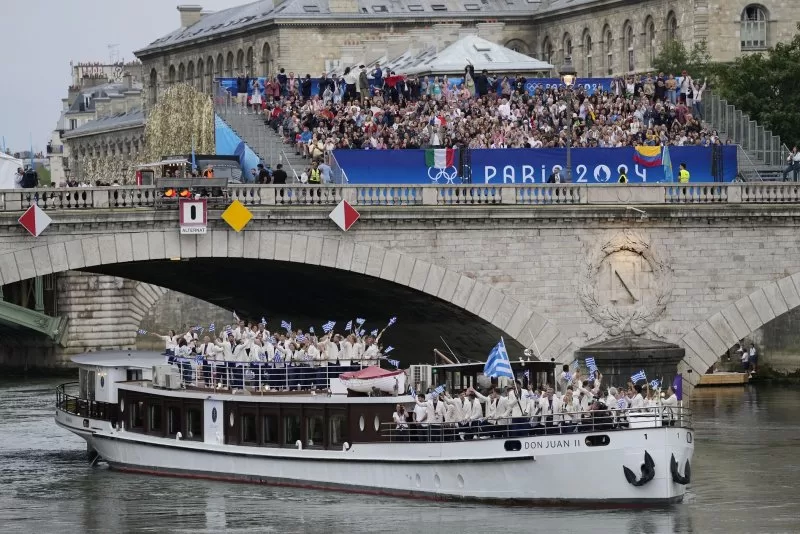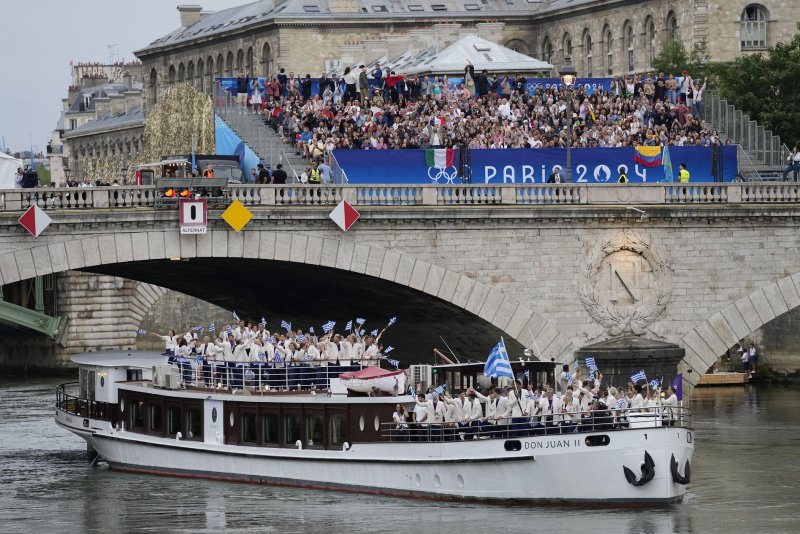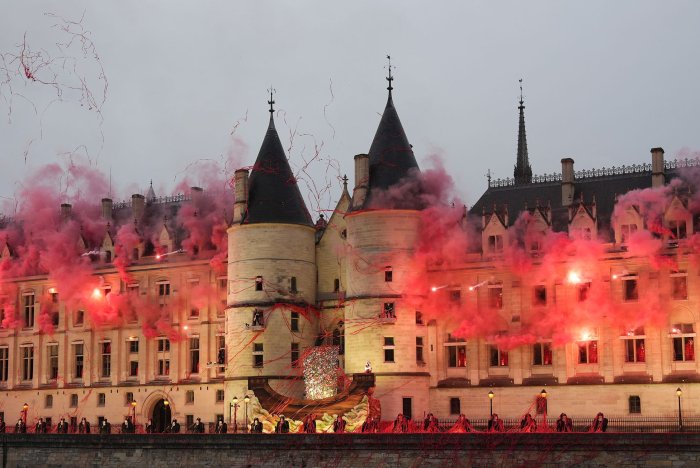1 of 13 | A boat carrying athletes from Team Greece travels on the river Seine in the Parade of Nations during the Opening Ceremony of the Paris 2024 Olympic Games in Paris on Friday, Photo by Paul Hanna/UPI |
License PhotoJuly 23 (UPI) — The long-anticipated opening ceremony of the Paris 2024 Olympics launched Friday with an athletes’ parade aboard dozens of vessels in a flotilla along the river Seine and a performance by pop superstar Lady Gaga.
Hundreds of thousands of spectators lined the banks of the waterway amid a steady rain to cheer on the athletes as they passed on specially equipped boats en route to the Trocadero in the shadow of the Eiffel Tower.
There, they were to disembark for the lighting of the Olympic Cauldron, signaling the official start to the games.
The ceremony began at 7:30 p.m. local time despite nationwide travel chaos caused by a series of coordinated arson attacks on the French high-speed TGV rail system carried out by unknown saboteurs.
The National Olympic Committee of France touted its opening ceremony as plans as “bold, original and unique,” certain to “join the most memorable moments in Olympic history.”
First and foremost, the planners chose to hold the ceremony not in a stadium, but rather in Paris itself, specifically along the city’s “main artery,” the Seine.
Under the concept, the traditional parade of athletes was transformed into a waterborne procession of boats, one for each of the larger national delegations. Each of the nearly 100 boats were equipped with cameras to allow for up-close viewing,
The idea was to allow more than 300,000 spectators the chance to see the athletes’ parade in person, something never before accomplished at an Olympics. Eighty giant video screens were set up throughout the city to allow those who couldn’t make it in person to view the ceremony.
Beginning at the Austerlitz Bridge next to the Jardin des Plantes, more than 10,000 athletes were positioned on the flotilla moving from east to west for nearly 4 miles along the Seine.
Along the way, it passed by two islands — the Île Saint Louis and the Île de la Cité — and under several bridges, each hosting dozens of dancers performing pieces by choreographer Maud Le Pladec and wearing costumes designed by Daphne Burki.
The dancers’ participation remained in doubt as the Opening Ceremony approached. The union representing the artists, SFA-CGT, went on strike against Paname24, the executive producer of the ceremonies, on July 17 citing what it called “glaring inadequacies” in the treatment of performers.
On Wednesday, however, the union ended its action after receiving a final offer from the organizers in what its leaders called “a victory, though not a total one.”
The athletes’ boat parade route ended at the Iena Bridge, opposite the Trocadero, the monumental plaza in the heart of Paris that features iconic museums, sculptures, gardens and fountains, as well as sweeping views of the Eiffel Tower.
Once there, the athletes emerged onto the grand esplanade, where the final stages of the Opening Ceremony were set to be carried out, including the lighting of the Olympic cauldron and the declaration of the opening of the Paris 2024 Games.
The Greek delegation was the first to take to the water on the vessel Don Juan II, while the Ukrainian delegation received a standing ovation as they passed under the Pont de Bercy.
Among the flag bearers scheduled to participate were NBA star LeBron James for the United States, hammer thrower Anita Włodarczyk for Poland, basketball star Giannis Antetokounmpo for Greece and high jumpers Mutaz Essa Barshim for Qatar and Gianmarco Tamberi for Italy.
Heads of state, royalty, dignitaries attend
A long list of dignitaries and heads of state were expected to attend the Opening Ceremony, including heads of state such as British Prime Minister Keir Starmer, German Chancellor Olaf Scholz, Italian President Sergio Mattarella, Finnish President Alexander Stubb, Greek Prime Minister Kyriakos Mitsotakis.
Ten heads of state from the African continent were also due to take part, such as the Mauritania’s Mohamed Ould Ghazouani, the current president of the African Union, an the Rwandan leader Paul Kagame.
First lady Jill Biden was expected to represent the United States, while the British Royal Family was to be represented by Princess Anne, sister of King Charles III.
Meanwhile, conspicuous by their absences were Russian President Vladimir Putin and Chinese counterpart Xi Jinping.
Lady Gaga kicks off entertainment with performance along Seine
American pop superstar Lady Gaga provided the first entertainment spectacle of the evening, appearing in a tribute to French cabaret and music hall with an performance of the 1960s hit “Mon truc en plumes” by Zizi Jeanmaire.
She appeared on a staircase along the Seine in a black outfit surrounded by dancers carrying pink pom poms and feathers.
As the ceremony progressed, a mysterious cloaked person cariying the Olympic torch was followed by cameras as they moved through a series of scenes staged live at sites in the French capital representing the French motto of “Liberté, Egalité, Fraternité.”
At the Théâtre du Châtelet, the torchbearer was shown at a rehearsal of the musical comedy “Les Misérables,” while classical opera singer Marina Viotti and heavy metal band Gojira performed the French revolutionary song “Ah, ça ira.”
Next, classical opera singer Marina Viotti, the Paris Symphony Orchestra and its choir sung the aria from Georges Bizet’s opera Carmen, “L’amour est un oiseau rebelle” (also known as “La Habanera”).
French-Malian pop superstar Aya Nakamura and the orchestra of the French Republican Guard was up next with a contingent of 36 singers from the French Army performing her hits “Pookie.” “Djadja” and Charles Aznavour’s “For Me Formidable” and “La Bohème.”
On the roof of the Grand-Palais, mezzo-soprano Axelle Saint-Cirel sung a moving rendition of “La Marseillaise,” the French national anthem, while clothed in a French flag dress made by House of Dior.
The entertainment acts for the Opening Ceremony were kept secret under orders from French theater director and actor Thomas Jolly, who served as the event’s artistic director. Organizers, however, promised “the greatest spectacle of the 21st century.”
Celine Dion turned up in Paris in the run-up to the ceremony and anticipation was running high the 56-year-old French Canadian icon would make a comeback from neurological disease at the event in her first public appearance since 2020.
Rumors was so intense that French President Emmanuel Macron was asked during a television interview Tuesday if Dion would perform. He responded by saying he could not reveal anything, but offered, “That would be great because she is an immense artist.”
The speculation gained more credibility on Thursday when Dion was photographed meeting with Macron’s wife Brigitte at the Royal Monceau Hotel.
Attacks on high-speed rail lines create chaos
The arson attacks on France’s high-speed rail system came just as organizers were putting the finishing touches on the opening ceremony and also coincided with the start of the “grand départ,” the day millions of Parisians traditionally leave the city for their summer vacation.
The massive “sabotage” attacks affected at least 800,000 travelers, as French rail operator SNCF was forced to cancel or divert a large number of trains on three of its four main 200-mph TGV lines.
Paris particularly badly hit, SNCF Group President Jean-Pierre Farandou told French television network BFMTV.
The railway sabotage, however, will have “no impact on the opening ceremony,” Paris Mayor Anne Hildalgo told reporters following a meeting with King Felipe VI of Spain.
“What happened is unacceptable, but it will have no impact on this evening’s ceremony, because it has no consequences on the transport network of the Ile-de-France region,” she said.
International Olympic Committee President Thomas Bach also brushed off worries the attacks would disrupt the opening ceremony.
“I don’t have concerns, we have full confidence in the French authorities,” he told the BBC. “All the measures are being taken. The French authorities are assisted by 180 other intelligence services around the world.
“We have good reason to have full confidence.”
Chances of rain worries organizers
While the assault on France’s railways were not expected to disrupt the ceremony, fears mounted that an uncooperative Mother Nature could.
A note of caution was sounded earlier in the week amid the pre-ceremony hoopla as rain crept into the forecast, threatening to throw a monkey wrench into the exquisitely planned proceedings.
The concerns were first noted Tuesday and immediately triggered fears that not only would rain dampen the spectator turnout along the Seine but also scuttle the flotilla plans themselves.
Heavy rain could affect the flow of the river, making it run faster and thus speeding up the boats, which would throw off the precise timing of the event.
Organizers were also concerned that rising river levels could make some of the larger vessels too high to pass under the bridges, according to broadcaster FranceInfo.
Twenty-four hours before the event, weather agency La Chaîne Météo said it remained difficult to predict with accuracy if rain would fall in Paris during the ceremony, but put the chances of rain at 30%.
However, as Friday dawned, the official Météo-France agency significantly ramped up its warnings, issuing a “yellow alert” for flooding in the French capital starting at 8 p.m. local time, coinciding with the ceremony.
Rain began falling on Friday morning, with 0.2 inches recorded. A lull was expected during the afternoon hours followed by “continuous, sometimes sustained” precipitation in the evening with as much as an additional half-inch falling. Higher amounts were possible, forecasters warned.
Tight security along the Seine, disrupted traffic
Strict security zones were set up along the Seine, including “red zones” extending outwards from the river in which automobiles were banned, and “grey zones” along its banks accessible only to local residents, athletes, accredited Paris 2024 personnel and visitors with a reservation at a business.
By Wednesday, normal activity at many points in the grey zones had all but ceased as quays were emptied and the city’s ubiquitous street vendors were nowhere to be seen.
Only a few cyclists and pedestrians were visible at normally bustling tourist hotspots such as the Louvre Museum, the Quai d’Orsay and the Hôtel des Invalides military museum, Belgian broadcaster RTBF reported.
More the 45,000 French police and gendarmes were deployed across the city by Friday evening, including snipers apparently positioned atop the Arc de Triomphe
French officials advised residents to steer clear of not just the Seine area but to avoid driving in the city as a whole on Friday night due to the extensive security precautions.
Securing the perimeter of the ceremony “will have a significant impact on traffic conditions in Paris and its suburbs.” producing “extremely difficult” traffic conditions, warned Minister of Transport Patrice Vergriete.
Dancers perform in front of the Conciergerie, a former prison and part of a former royal palace on the banks of the Seine river during the opening ceremony of the Paris 2024 Olympic Games in Paris on July 26, 2024. Photo by Paul Hanna/UPI |
License Photo


